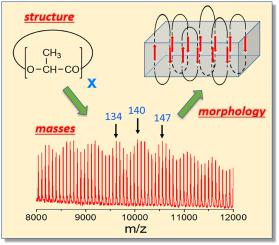Polymer ( IF 4.1 ) Pub Date : 2022-11-14 , DOI: 10.1016/j.polymer.2022.125516 Hans R. Kricheldorf , Steffen M. Weidner , Andreas Meyer

|
L-Lactide was polymerized in bulk at 140 °C with three different cyclic tin catalysts and the time was varied from 1 d up to 14 d. The MALDI TOF spectra confirmed the formation of cyclic polylactides (PLAs) and displayed a characteristic change of peak intensity distribution with formation of a “saw tooth pattern”. This pattern confirms a previous hypothesis that cyclic PLAs tend to form crystallites with extended ring conformation and relatively smooth surface. This type of crystallites is formed under thermodynamic control by transesterification on the surface of the crystallites. In this way PLAs with extraordinarily high melting temperatures (Tm's up to 200.6 °C) and extraordinarily high melting enthalpy were obtained (ΔHm's up to 105 J g−1). These ΔHm values require a revision of the maximum ΔHm value calculated in the literature for ideal PLA crystals.
中文翻译:

L-丙交酯与环锡催化剂的环扩展聚合 (REP) – 关于扩展环晶体的形成和 Tm 和 ΔHm 的优化
L-丙交酯在 140 °C 下使用三种不同的环状锡催化剂进行本体聚合,时间从 1 天到 14 天不等。MALDI TOF 光谱证实了环状聚丙交酯 (PLA) 的形成,并显示出峰强度分布的特征变化,并形成了“锯齿图案”。这种模式证实了先前的假设,即环状 PLA 倾向于形成具有扩展环构象和相对光滑表面的微晶。这种类型的微晶是在热力学控制下通过微晶表面的酯交换反应形成的。通过这种方式,获得了具有极高熔化温度(T m高达 200.6 °C)和极高熔化焓(ΔH m高达 105 J g -1)的 PLA。这些ΔHm值需要修改文献中计算的理想 PLA 晶体的最大 ΔH m值。







































 京公网安备 11010802027423号
京公网安备 11010802027423号